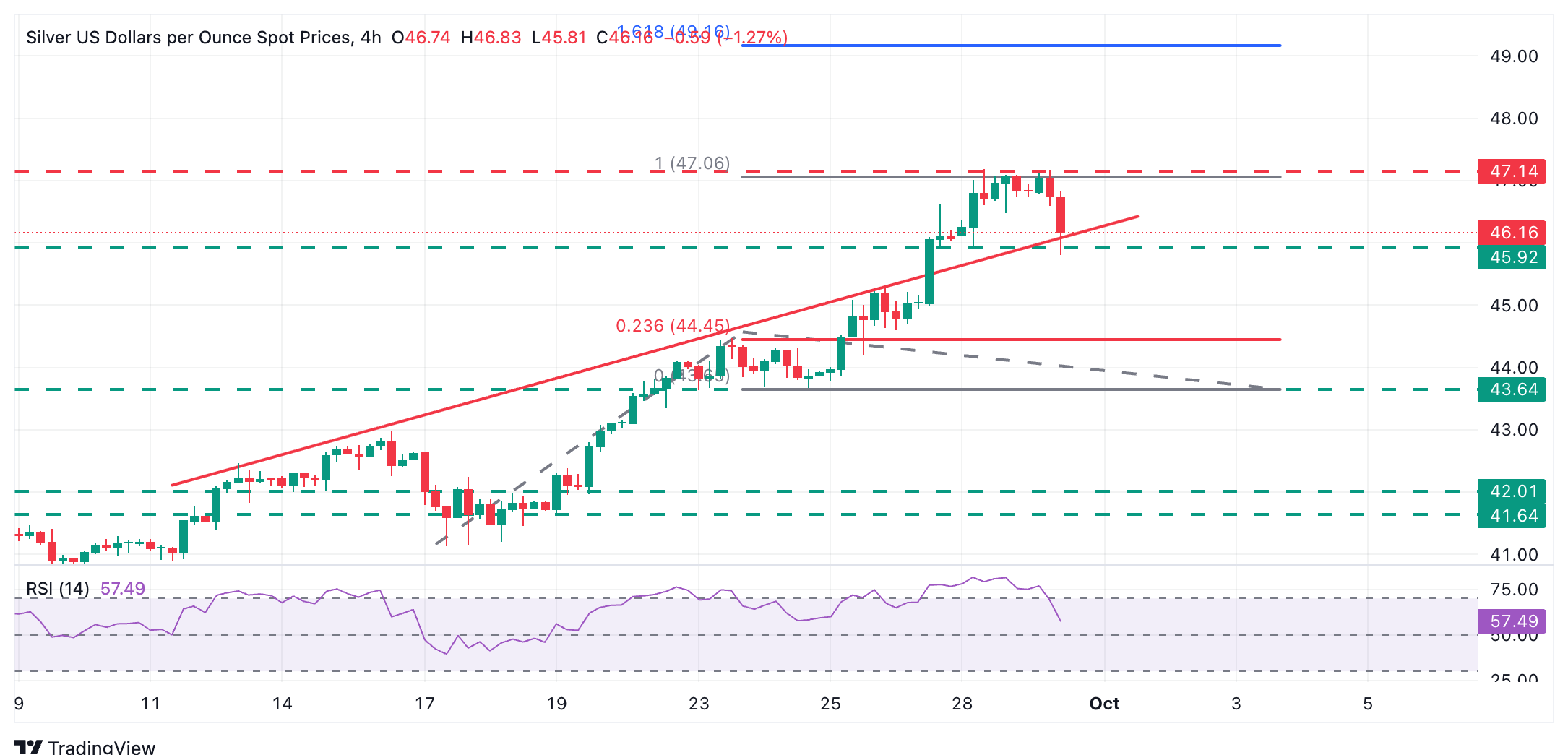Silver Price Forecast: XAG/USD rejected at $47.00, hits levels below $46.00
- Silver retreated from session lows sub-$46.00 after rejection above $47.00.
- Precious metals are correcting lower on Tuesday as the US Dollar sell-off stalls.
- XAG/USD’s bears are pushing against the $46.00 support area at the time of writing.
Silver (XAG/USD) has snapped a three-day rally on Tuesday, as the pair failed to consolidate at levels beyond $47.00, and retreated to session lows below $45.80, before returning to levels right above the $46.00 line
Precious metals are correcting lower from long-term highs on Tuesday. Investors remain wary about a potential shutdown of the federal government, but the US Dollar sell-off seen in previous days has stalled.
Technical Analysis: Silver is in a bearish correction from long-term highs

Everything that goes up must come down, and Silver is not different. The technical picture shows a healthy bearish correction in progress, with the 4-Hour Relative Strength Index coming down from strongly overbought levels.
A reverse trendline resistance is acting as support in the area of the September 29 lows, between $45.90 and $46.10, holding bears for now. Further down, the previous long-term highs, at $45.30 (September 25 high) and $44.45 (September 23 high) would come into focus.
To the upside, immediate resistance lies at Tuesday’s high. to $47.15.Beyond here, e, Fibonacci tool shows the 161.8% extension of the September 17-23 bullish run, at $49.15.
Silver FAQs
Silver is a precious metal highly traded among investors. It has been historically used as a store of value and a medium of exchange. Although less popular than Gold, traders may turn to Silver to diversify their investment portfolio, for its intrinsic value or as a potential hedge during high-inflation periods. Investors can buy physical Silver, in coins or in bars, or trade it through vehicles such as Exchange Traded Funds, which track its price on international markets.
Silver prices can move due to a wide range of factors. Geopolitical instability or fears of a deep recession can make Silver price escalate due to its safe-haven status, although to a lesser extent than Gold's. As a yieldless asset, Silver tends to rise with lower interest rates. Its moves also depend on how the US Dollar (USD) behaves as the asset is priced in dollars (XAG/USD). A strong Dollar tends to keep the price of Silver at bay, whereas a weaker Dollar is likely to propel prices up. Other factors such as investment demand, mining supply – Silver is much more abundant than Gold – and recycling rates can also affect prices.
Silver is widely used in industry, particularly in sectors such as electronics or solar energy, as it has one of the highest electric conductivity of all metals – more than Copper and Gold. A surge in demand can increase prices, while a decline tends to lower them. Dynamics in the US, Chinese and Indian economies can also contribute to price swings: for the US and particularly China, their big industrial sectors use Silver in various processes; in India, consumers’ demand for the precious metal for jewellery also plays a key role in setting prices.
Silver prices tend to follow Gold's moves. When Gold prices rise, Silver typically follows suit, as their status as safe-haven assets is similar. The Gold/Silver ratio, which shows the number of ounces of Silver needed to equal the value of one ounce of Gold, may help to determine the relative valuation between both metals. Some investors may consider a high ratio as an indicator that Silver is undervalued, or Gold is overvalued. On the contrary, a low ratio might suggest that Gold is undervalued relative to Silver.

